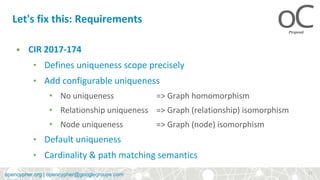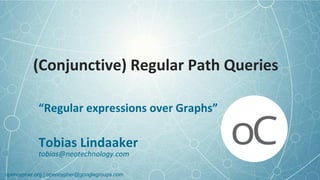Future features for openCypher: Schema, Constraints, Subqueries, Configurable Pattern Matching, Conjunctive regular Path Queries
- 1. opencypher.orgopencypher.org | opencypher@googlegroups.com Schema and Constraints Mats Rydberg mats@neotechnology.com
- 2. opencypher.orgopencypher.org | opencypher@googlegroups.com ● Cypher is schema-optional ● Fits well with heterogenous data ● Makes typing and query planning harder ● Does not fit well with many existing table-based engines ● Constraints are the only tools to enforce structure in the data Schema in Cypher is a point where we expect there to be major developments as more actors get involved. Schema in Cypher 2
- 3. opencypher.orgopencypher.org | opencypher@googlegroups.com ● Consistent syntax for all types of constraints (CIP) ● Re-use as much as possible from the rest of the language ● Allow for a large set of future constraints, some of which are vendor-specific ● This allows vendors to use more strict schema when necessary CREATE CONSTRAINT <name> FOR <simple pattern> REQUIRE <constraint expression> New constraint syntax 3
- 4. opencypher.orgopencypher.org | opencypher@googlegroups.com ● Property uniqueness constraint ➢ CREATE CONSTRAINT unique_person_names FOR (p:Person) REQUIRE UNIQUE p.firstName, p.lastName ● Property existence constraint ➢ CREATE CONSTRAINT person_must_have_firstName FOR (p:Person) REQUIRE exists(p.firstName) Constraints, examples 4
- 5. opencypher.orgopencypher.org | opencypher@googlegroups.com ● Property value constraint ➢ CREATE CONSTRAINT roads_must_have_positive_finite_length FOR ()-[r:ROAD]-() REQUIRE 0 < r.distance < infinity ● Property type constraint ➢ CREATE CONSTRAINT people_schema FOR (p:Person) REQUIRE p.email IS STRING REQUIRE p.name IS STRING? REQUIRE p.age IS INTEGER? Constraints, examples 5
- 6. opencypher.orgopencypher.org | opencypher@googlegroups.com ● Cardinality constraints ➢ CREATE CONSTRAINT spread_the_love FOR (p:Person) REQUIRE size((p)-[:LOVES]->()) > 3 ● Endpoint constraints ➢ CREATE CONSTRAINT can_only_own_things FOR ()-[:OWNS]->(t) REQUIRE (t:Vehicle) OR (t:Building) OR (t:Object) ● Label coexistence constraints ➢ CREATE CONSTRAINT programmers_are_people_too FOR (p:Programmer) REQUIRE p:Person Constraints, examples 6
- 7. opencypher.orgopencypher.org | opencypher@googlegroups.com That's it! Questions ?
- 8. opencypher.orgopencypher.org | opencypher@googlegroups.com Subqueries Petra Selmer petra.selmer@neotechnology.com
- 9. opencypher.orgopencypher.org | opencypher@googlegroups.com MATCH (actor:Actor) WHERE EXISTS { (actor)-[:ACTED_IN]->(movie), (other:Actor)-[:ACTED_IN]->(movie) WHERE other.name = actor.name AND actor <> other } RETURN actor Existential subqueries CIP 9
- 10. opencypher.orgopencypher.org | opencypher@googlegroups.com MATCH (f:Farm {id: $farmId})-[:IS_IN]->(country:Country) MATCH { MATCH (u:User {id: $userId})-[:LIKES]->(b:Brand) RETURN b AS item, b.designedDate AS dateOfInterest UNION MATCH (u:User {id: $userId})-[:BOUGHT]->(v:Vehicle) WHERE v.leftHandDrive = country.leftHandDrive RETURN v AS item, v.manufacturedDate AS dateOfInterest } RETURN DISTINCT v.code ORDER BY dateOfInterest Nested correlated subqueries CIP 10
- 11. opencypher.orgopencypher.org | opencypher@googlegroups.com MATCH (r:Root) DO { UNWIND range(1, 10) AS x MERGE (c:Child {id: x}) MERGE (r)-[:PARENT]->(c) } ● UNWIND manages the looping ● DO suppresses the increased cardinality from the inner query ● DO hides all new variable bindings (e.g. c) Nested read/write subqueries CIP 11
- 12. opencypher.orgopencypher.org | opencypher@googlegroups.com MATCH (actor:Actor) WHERE actor.age > { MATCH (director:Director)-[:DIRECTED]->(:Movie) RETURN max(director.age) } RETURN actor.name, actor.details Scalar subqueries 12 CIR
- 13. opencypher.orgopencypher.org | opencypher@googlegroups.com That's it! Questions ?
- 14. opencypher.orgopencypher.org | opencypher@googlegroups.com Homomorphic and Isomorphic Pattern Matching Stefan Plantikow stefan.plantikow@neotechnology.com
- 15. opencypher.orgopencypher.org | opencypher@googlegroups.com • MATCH(a)-[r]->(b) ≡ { (a, r, b) V E V | r (a,b) } • MATCH (a)-[r1]->(b)-[r2]->(c) ≡ { (a, r1 , b, r2 , c) V E V E V | r 1 (a,b) r 2 (b,c) r1 ≠ r2 } • MATCH (a)-[rs*]->(b) ≡ { (a, rs, b) V E* V | rs * (a,b) rs=[...,r1 ...,r2 ,...] r1 ≠ r2 } Basic Pattern Matching Semantics 15
- 16. opencypher.orgopencypher.org | opencypher@googlegroups.com • Why? • No uniqueness Potentially infinitely many matching paths • Node uniqueness Can't match self-loops • When? • All pattern variables in a MATCH • And similar constructs (comprehensions etc.) • Optional? • Not for variable length Default Uniqueness = Relationship Uniqueness 16
- 17. opencypher.orgopencypher.org | opencypher@googlegroups.com • CIR 2017-174 • Defines uniqueness scope precisely • Add configurable uniqueness • No uniqueness => Graph homomorphism • Relationship uniqueness => Graph (relationship) isomorphism • Node uniqueness => Graph (node) isomorphism • Default uniqueness • Cardinality & path matching semantics Let's fix this: Requirements 17
- 18. opencypher.orgopencypher.org | opencypher@googlegroups.com • CIP 2017-01-18 • Uniqueness mode specifiers • MATCH ALL (a)-[r*]->(b) • MATCH UNIQUE RELATIONSHIPS • MATCH UNIQUE NODES • Subquery uniqueness mode specifiers • MATCH [MODE] { ... } • DO [MODE] { ... } Let's fix this: Proposal 18
- 19. opencypher.orgopencypher.org | opencypher@googlegroups.com • CIP 2017-01-18: Path predicates • MATCH ALL p=()-[:T1*]->()<-[r:T2]->() WHERE ... • node-isomorphic nodeUnique(p) • relationship-isomorphic relUnique(p) • has cycles | has no cycles open(p)|closed(p) • no immediately repeated rels trek(p) • no repeated cycles NOT redundant(p) • ... Let's fix this: Proposal 19
- 20. opencypher.orgopencypher.org | opencypher@googlegroups.com That's it! Questions ?
- 21. opencypher.orgopencypher.org | opencypher@googlegroups.com (Conjunctive) Regular Path Queries “Regular expressions over Graphs” Tobias Lindaaker tobias@neotechnology.com
- 22. opencypher.orgopencypher.org | opencypher@googlegroups.com We’ve been wanting to do this for long Been trying to find well balanced syntax 22
- 23. opencypher.orgopencypher.org | opencypher@googlegroups.com Regular Path Patterns • Disjunctions (unions) between patterns: (a)-/alt1 | alt2 | alt3/-(b) • Sequence of patterns: (a)-/first second third/->(b) • Repetition of pattern: (a)<-/(many times)*/-(b) • Definition of complex pattern predicates: MATCH (a)-/complex/->(b) PATH (x)-/complex/->(y) IS (x)-[:LOVES]->(y), (y)-[:HATES]->(x) • Shorthand for simple predicates: (a)-/:REGULAR_RELATIONSHIP_TYPE/->(b) • Combinations of the above 23 (CIP2017-02-06)
- 24. opencypher.orgopencypher.org | opencypher@googlegroups.com Origins of the syntax in CIP2017-02-06 “Canterbury Style” (from a meeting in Canterbury, summer 2015) ● In-line pattern expression MATCH p=(a:Person{a})[ (x)-[:AUTHORED]->(:Book)<-[:AUTHORED]-(y) WHERE x <> y ]*(b:Person{b}) RETURN p ORDER BY length(p) ASC LIMIT 1 Pros ● Pattern visible where used Cons ● Large patterns, hard to overview 24 “PGQL Style” (inspired by the path patterns in PGQL) ● Composition of simple pattern declarations PATH CO_AUTHORED := (x)-[:AUTHORED]->(:Book)<-[:AUTHORED]-(y) WHERE x <> y MATCH p=(a:Person{a})-/CO_AUTHORED*/-(b:Person{b}) RETURN p ORDER BY length(p) ASC LIMIT 1 Pros ● No nested syntax, each pattern is clear ● Allows reuse of complex sub-pattern ● Pattern definitions align with “path-views” Cons ● Definition removed from use ● Everything needs to be declared to be used ● Unclear which nodes are input, and which are internal to a PATH pattern
- 25. opencypher.orgopencypher.org | opencypher@googlegroups.com Syntax tradeoffs Desirable • Pattern visible where used • No unnecessary ceremony • Transparent complexity • Familiar regular language • Allow reuse of complex sub-patterns Undesirable • Lots of details in patterns - hard to view structure • Definition of pattern removed from use • Very many ways to express the same thing 25
- 26. opencypher.orgopencypher.org | opencypher@googlegroups.com Evolving from Cypher today • Limited support today: • Disjunction on edge label: ()-[:A|B|C]->() • Repetition of single edge: ()-[:X*]->() • unhelpful when binding: ()-[x:X*]->() - binds as list! • (these two forms can be combined) • Regular Path Patterns replace existing repetition syntax • For CRPQs (Conjunctive Regular Path Queries) Cypher need only add Regular Path Patterns, it already has conjunctions 26
- 27. opencypher.orgopencypher.org | opencypher@googlegroups.com Expressive powerComparing to GXPath (path expressions) • ⟦ε⟧G - {(v,v) | v ∈ V} - yes: PATH (a)-/nop/-(a) IS (a) • ⟦_⟧G - {(v,w)| (v,a,w) ∈ E for some a} - yes: PATH (a)-/any/->(b) IS (a)-->(b) • ⟦a⟧G - {(v,w)| (v,a,w) ∈ E} - yes: (v)-/:a/->(w) • ⟦a- ⟧G = {(v,w) | (w,a,v) ∈ E} - yes: (v)-/<:a/->(w) • ⟦ɑ*⟧G = reflexive transitive closure of ɑ - yes: ()-/ɑ*/->() • ⟦ɑ · β⟧G = ⟦ɑ⟧G ⟦β⟧G - yes: ()-/ɑ β/->() • ⟦ɑ ∪ β⟧G = ⟦ɑ⟧G ∪ ⟦β⟧G - yes: ()-/ɑ|β/->() • ⟦¬ɑ⟧G = V V - ⟦ɑ⟧G - maybe: PATH (v)-/not_alpha/->(w) IS (v), (w) WHERE NOT EXISTS { (v)-/ɑ/->(w) } Warning: the above is intractable, we might want to restrict to connected patterns • ⟦[φ]⟧G = {(v,v) | v ∈ ⟦φ⟧G } - yes: PATH (v)-/phi/-(v) IS (v) WHERE φ • ⟦ɑn,m ⟧G = ⋃k=n m (⟦ɑ⟧G )k - yes: ()-/ɑ*n..m/->() • ⟦ɑ= ⟧G = {(v,w) ∈ ⟦ɑ= ⟧G | ρ(v)=ρ(w)} - yes: PATH (v)-/alpha_eq/->(w) IS (v)-/ɑ/->(w) WHERE v.ρ = w.ρ • ⟦ɑ≠ ⟧G = {(v,w) ∈ ⟦ɑ= ⟧G | ρ(v)≠ρ(w)} - yes: PATH (v)-/alpha_not_eq/->(w) IS (v)-/ɑ/->(w) WHERE v.ρ <> w.ρ • Conjunctions (for CRPQs): ⟦ɑ ∩ β⟧G = ⟦ɑ⟧G ∪ ⟦β⟧G - yes: PATH (v)-/alpha_and_beta/->(w) IS (v)-/ɑ/->(w), (v)-/β/->(w) 2 7 27Querying Graphs with Data - L.Libkin, W.Martens, D.Vrgoč
- 28. opencypher.orgopencypher.org | opencypher@googlegroups.com Expressive power Comparing to GXPath (node tests) • ⟦⟨ɑ⟩⟧G = {v | ∃w (v,w) ∈ ⟦ɑ⟧G } - yes: PATH (v)-/has_alpha/-(v) IS (v)-/ɑ/->() • ⟦¬φ⟧G = V - ⟦φ⟧G - yes: PATH (v)-/not_phi/-(v) IS (v) WHERE NOT φ • ⟦φ ∧ ψ⟧G = ⟦φ⟧G ∩ ⟦ψ⟧G - yes: PATH (v)-/phi_and_psi/-(v) IS (v) WHERE φ AND ψ • ⟦φ ∨ ψ⟧G = ⟦φ⟧G ∪ ⟦ψ⟧G - yes: PATH (v)-/phi_or_psi/-(v) IS (v) WHERE φ OR ψ • ⟦c= ⟧G = {v ∈ V | ρ(v) = c} - yes: PATH (v)-/rho_is_c/-(v) IS (v) WHERE v.ρ = c • ⟦c≠ ⟧G = {v ∈ V | ρ(v) ≠ c} - yes: PATH (v)-/rho_is_c/-(v) IS (v) WHERE v.ρ <> c • ⟦⟨ɑ = β⟩⟧G = {v ∈ V | ∃w,y (v,w)∈⟦ɑ⟧G , (v,y)∈⟦β⟧G , ρ(w)=ρ(y)} - yes: PATH (v)-/alpha_eq_beta/-(v) IS (v)-/ɑ/->(w), (v)-/β/->(y) WHERE w.ρ = y.ρ • ⟦⟨ɑ ≠ β⟩⟧G = {v ∈ V | ∃w,y (v,w)∈⟦ɑ⟧G , (v,y)∈⟦β⟧G , ρ(w)≠ρ(y)} - yes: PATH (v)-/alpha_not_eq_beta/-(v) IS (v)-/ɑ/->(w), (v)-/β/->(y) WHERE w.ρ <> y.ρ 2 8 28Querying Graphs with Data - L.Libkin, W.Martens, D.Vrgoč
- 29. opencypher.orgopencypher.org | opencypher@googlegroups.com Can we do even better? • Shorthand syntax for node labels • Shorthand syntax for matching any edge • Shorthand syntax for property predicates • What is the scope of PATH declarations? • ...and where in the query should they go? • Beginning of query? • Sub-clause of MATCH? • Anywhere in the query? • Can we parameterize PATH declarations? • ...and use parameters for both input and output... 2 9 29
- 30. opencypher.orgopencypher.org | opencypher@googlegroups.com <Your suggestion here> What other features would you like to see in Cypher?




![opencypher.orgopencypher.org | opencypher@googlegroups.com
● Property value constraint
➢ CREATE CONSTRAINT roads_must_have_positive_finite_length
FOR ()-[r:ROAD]-()
REQUIRE 0 < r.distance < infinity
● Property type constraint
➢ CREATE CONSTRAINT people_schema
FOR (p:Person)
REQUIRE p.email IS STRING
REQUIRE p.name IS STRING?
REQUIRE p.age IS INTEGER?
Constraints, examples
5](https://image.slidesharecdn.com/opencypherlanguageevolutionfuturefeatures-180111104015/85/Future-features-for-openCypher-Schema-Constraints-Subqueries-Configurable-Pattern-Matching-Conjunctive-regular-Path-Queries-5-320.jpg)
![opencypher.orgopencypher.org | opencypher@googlegroups.com
● Cardinality constraints
➢ CREATE CONSTRAINT spread_the_love
FOR (p:Person)
REQUIRE size((p)-[:LOVES]->()) > 3
● Endpoint constraints
➢ CREATE CONSTRAINT can_only_own_things
FOR ()-[:OWNS]->(t)
REQUIRE (t:Vehicle) OR (t:Building) OR (t:Object)
● Label coexistence constraints
➢ CREATE CONSTRAINT programmers_are_people_too
FOR (p:Programmer)
REQUIRE p:Person
Constraints, examples
6](https://image.slidesharecdn.com/opencypherlanguageevolutionfuturefeatures-180111104015/85/Future-features-for-openCypher-Schema-Constraints-Subqueries-Configurable-Pattern-Matching-Conjunctive-regular-Path-Queries-6-320.jpg)


![opencypher.orgopencypher.org | opencypher@googlegroups.com
MATCH (actor:Actor)
WHERE EXISTS {
(actor)-[:ACTED_IN]->(movie),
(other:Actor)-[:ACTED_IN]->(movie)
WHERE other.name = actor.name
AND actor <> other
}
RETURN actor
Existential subqueries
CIP
9](https://image.slidesharecdn.com/opencypherlanguageevolutionfuturefeatures-180111104015/85/Future-features-for-openCypher-Schema-Constraints-Subqueries-Configurable-Pattern-Matching-Conjunctive-regular-Path-Queries-9-320.jpg)
![opencypher.orgopencypher.org | opencypher@googlegroups.com
MATCH (f:Farm {id: $farmId})-[:IS_IN]->(country:Country)
MATCH {
MATCH (u:User {id: $userId})-[:LIKES]->(b:Brand)
RETURN b AS item, b.designedDate AS dateOfInterest
UNION
MATCH (u:User {id: $userId})-[:BOUGHT]->(v:Vehicle)
WHERE v.leftHandDrive = country.leftHandDrive
RETURN v AS item, v.manufacturedDate AS dateOfInterest
}
RETURN DISTINCT v.code
ORDER BY dateOfInterest
Nested correlated subqueries
CIP
10](https://image.slidesharecdn.com/opencypherlanguageevolutionfuturefeatures-180111104015/85/Future-features-for-openCypher-Schema-Constraints-Subqueries-Configurable-Pattern-Matching-Conjunctive-regular-Path-Queries-10-320.jpg)
![opencypher.orgopencypher.org | opencypher@googlegroups.com
MATCH (r:Root)
DO {
UNWIND range(1, 10) AS x
MERGE (c:Child {id: x})
MERGE (r)-[:PARENT]->(c)
}
● UNWIND manages the looping
● DO suppresses the increased cardinality from the inner query
● DO hides all new variable bindings (e.g. c)
Nested read/write subqueries
CIP
11](https://image.slidesharecdn.com/opencypherlanguageevolutionfuturefeatures-180111104015/85/Future-features-for-openCypher-Schema-Constraints-Subqueries-Configurable-Pattern-Matching-Conjunctive-regular-Path-Queries-11-320.jpg)
![opencypher.orgopencypher.org | opencypher@googlegroups.com
MATCH (actor:Actor)
WHERE actor.age > {
MATCH (director:Director)-[:DIRECTED]->(:Movie)
RETURN max(director.age)
}
RETURN actor.name, actor.details
Scalar subqueries
12
CIR](https://image.slidesharecdn.com/opencypherlanguageevolutionfuturefeatures-180111104015/85/Future-features-for-openCypher-Schema-Constraints-Subqueries-Configurable-Pattern-Matching-Conjunctive-regular-Path-Queries-12-320.jpg)


![opencypher.orgopencypher.org | opencypher@googlegroups.com
• MATCH(a)-[r]->(b)
≡ { (a, r, b) V E V | r (a,b) }
• MATCH (a)-[r1]->(b)-[r2]->(c)
≡ { (a, r1
, b, r2
, c) V E V E V | r 1
(a,b) r 2
(b,c) r1
≠ r2
}
• MATCH (a)-[rs*]->(b)
≡ { (a, rs, b) V E*
V | rs *
(a,b) rs=[...,r1
...,r2
,...] r1
≠ r2
}
Basic Pattern Matching Semantics
15](https://image.slidesharecdn.com/opencypherlanguageevolutionfuturefeatures-180111104015/85/Future-features-for-openCypher-Schema-Constraints-Subqueries-Configurable-Pattern-Matching-Conjunctive-regular-Path-Queries-15-320.jpg)


![opencypher.orgopencypher.org | opencypher@googlegroups.com
• CIP 2017-01-18
• Uniqueness mode specifiers
• MATCH ALL (a)-[r*]->(b)
• MATCH UNIQUE RELATIONSHIPS
• MATCH UNIQUE NODES
• Subquery uniqueness mode specifiers
• MATCH [MODE] { ... }
• DO [MODE] { ... }
Let's fix this: Proposal
18](https://image.slidesharecdn.com/opencypherlanguageevolutionfuturefeatures-180111104015/85/Future-features-for-openCypher-Schema-Constraints-Subqueries-Configurable-Pattern-Matching-Conjunctive-regular-Path-Queries-18-320.jpg)
![opencypher.orgopencypher.org | opencypher@googlegroups.com
• CIP 2017-01-18: Path predicates
• MATCH ALL p=()-[:T1*]->()<-[r:T2]->() WHERE ...
• node-isomorphic nodeUnique(p)
• relationship-isomorphic relUnique(p)
• has cycles | has no cycles open(p)|closed(p)
• no immediately repeated rels trek(p)
• no repeated cycles NOT redundant(p)
• ...
Let's fix this: Proposal
19](https://image.slidesharecdn.com/opencypherlanguageevolutionfuturefeatures-180111104015/85/Future-features-for-openCypher-Schema-Constraints-Subqueries-Configurable-Pattern-Matching-Conjunctive-regular-Path-Queries-19-320.jpg)



![opencypher.orgopencypher.org | opencypher@googlegroups.com
Regular Path Patterns
• Disjunctions (unions) between patterns:
(a)-/alt1 | alt2 | alt3/-(b)
• Sequence of patterns:
(a)-/first second third/->(b)
• Repetition of pattern:
(a)<-/(many times)*/-(b)
• Definition of complex pattern predicates:
MATCH (a)-/complex/->(b)
PATH (x)-/complex/->(y) IS
(x)-[:LOVES]->(y), (y)-[:HATES]->(x)
• Shorthand for simple predicates:
(a)-/:REGULAR_RELATIONSHIP_TYPE/->(b)
• Combinations of the above
23
(CIP2017-02-06)](https://image.slidesharecdn.com/opencypherlanguageevolutionfuturefeatures-180111104015/85/Future-features-for-openCypher-Schema-Constraints-Subqueries-Configurable-Pattern-Matching-Conjunctive-regular-Path-Queries-23-320.jpg)
![opencypher.orgopencypher.org | opencypher@googlegroups.com
Origins of the syntax in CIP2017-02-06
“Canterbury Style”
(from a meeting in Canterbury, summer 2015)
● In-line pattern expression
MATCH p=(a:Person{a})[
(x)-[:AUTHORED]->(:Book)<-[:AUTHORED]-(y)
WHERE x <> y
]*(b:Person{b})
RETURN p ORDER BY length(p) ASC LIMIT 1
Pros
● Pattern visible where used
Cons
● Large patterns, hard to overview
24
“PGQL Style”
(inspired by the path patterns in PGQL)
● Composition of simple pattern declarations
PATH CO_AUTHORED :=
(x)-[:AUTHORED]->(:Book)<-[:AUTHORED]-(y)
WHERE x <> y
MATCH p=(a:Person{a})-/CO_AUTHORED*/-(b:Person{b})
RETURN p ORDER BY length(p) ASC LIMIT 1
Pros
● No nested syntax, each pattern is clear
● Allows reuse of complex sub-pattern
● Pattern definitions align with “path-views”
Cons
● Definition removed from use
● Everything needs to be declared to be used
● Unclear which nodes are input, and which are
internal to a PATH pattern](https://image.slidesharecdn.com/opencypherlanguageevolutionfuturefeatures-180111104015/85/Future-features-for-openCypher-Schema-Constraints-Subqueries-Configurable-Pattern-Matching-Conjunctive-regular-Path-Queries-24-320.jpg)

![opencypher.orgopencypher.org | opencypher@googlegroups.com
Evolving from Cypher today
• Limited support today:
• Disjunction on edge label: ()-[:A|B|C]->()
• Repetition of single edge: ()-[:X*]->()
• unhelpful when binding: ()-[x:X*]->() - binds as list!
• (these two forms can be combined)
• Regular Path Patterns
replace existing repetition syntax
• For CRPQs (Conjunctive Regular Path Queries)
Cypher need only add Regular Path Patterns,
it already has conjunctions
26](https://image.slidesharecdn.com/opencypherlanguageevolutionfuturefeatures-180111104015/85/Future-features-for-openCypher-Schema-Constraints-Subqueries-Configurable-Pattern-Matching-Conjunctive-regular-Path-Queries-26-320.jpg)
![opencypher.orgopencypher.org | opencypher@googlegroups.com
Expressive powerComparing to GXPath (path expressions)
• ⟦ε⟧G
- {(v,v) | v ∈ V} - yes: PATH (a)-/nop/-(a) IS (a)
• ⟦_⟧G
- {(v,w)| (v,a,w) ∈ E for some a}
- yes: PATH (a)-/any/->(b) IS (a)-->(b)
• ⟦a⟧G
- {(v,w)| (v,a,w) ∈ E} - yes: (v)-/:a/->(w)
• ⟦a-
⟧G
= {(v,w) | (w,a,v) ∈ E} - yes: (v)-/<:a/->(w)
• ⟦ɑ*⟧G
= reflexive transitive closure of ɑ
- yes: ()-/ɑ*/->()
• ⟦ɑ · β⟧G
= ⟦ɑ⟧G
⟦β⟧G
- yes: ()-/ɑ β/->()
• ⟦ɑ ∪ β⟧G
= ⟦ɑ⟧G
∪ ⟦β⟧G
- yes: ()-/ɑ|β/->()
• ⟦¬ɑ⟧G
= V V - ⟦ɑ⟧G
- maybe:
PATH (v)-/not_alpha/->(w) IS (v), (w)
WHERE NOT EXISTS { (v)-/ɑ/->(w) }
Warning: the above is intractable, we might want to restrict to connected patterns
• ⟦[φ]⟧G
= {(v,v) | v ∈ ⟦φ⟧G
}
- yes: PATH (v)-/phi/-(v) IS (v) WHERE φ
• ⟦ɑn,m
⟧G
= ⋃k=n
m
(⟦ɑ⟧G
)k - yes: ()-/ɑ*n..m/->()
• ⟦ɑ=
⟧G
= {(v,w) ∈ ⟦ɑ=
⟧G
| ρ(v)=ρ(w)}
- yes: PATH (v)-/alpha_eq/->(w) IS (v)-/ɑ/->(w) WHERE v.ρ = w.ρ
• ⟦ɑ≠
⟧G
= {(v,w) ∈ ⟦ɑ=
⟧G
| ρ(v)≠ρ(w)}
- yes: PATH (v)-/alpha_not_eq/->(w) IS (v)-/ɑ/->(w) WHERE v.ρ <> w.ρ
• Conjunctions (for CRPQs): ⟦ɑ ∩ β⟧G
= ⟦ɑ⟧G
∪ ⟦β⟧G
- yes: PATH (v)-/alpha_and_beta/->(w) IS (v)-/ɑ/->(w), (v)-/β/->(w)
2
7
27Querying Graphs with Data - L.Libkin, W.Martens, D.Vrgoč](https://image.slidesharecdn.com/opencypherlanguageevolutionfuturefeatures-180111104015/85/Future-features-for-openCypher-Schema-Constraints-Subqueries-Configurable-Pattern-Matching-Conjunctive-regular-Path-Queries-27-320.jpg)


